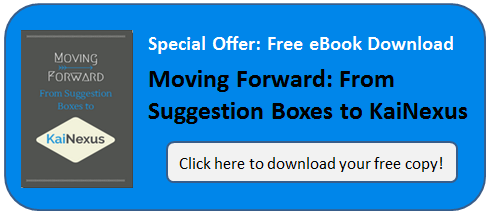 Thanks to an automated Google alert that I get on the topic of "suggestion box," I see a news article or blog post almost daily about the struggles or failures related to suggestion boxes.
Thanks to an automated Google alert that I get on the topic of "suggestion box," I see a news article or blog post almost daily about the struggles or failures related to suggestion boxes.
I'm surprised that this still surprises people.
Here's the most recent post, this time via Harvard Business Review (HBR): "Why Your Employees’ Suggestions Aren’t Going Anywhere."
Traditional suggestion box systems don't work. We at KaiNexus, sort of take that for granted by now.
Listen to this post as part of our podcast series:
The same problems are there whether you have a physical box that employees put paper into or if you're using web-based electronic suggestion box systems. Instead of wasting time and money on a suggestion box system, smart organizations looking to engage people in improving the organization invest in Kaizen-style improvement.
A Kaizen process is very different than a suggestion box, which is why it tends to work better. That's why KaiNexus' continuous improvement software is based on the Kaizen process, rather than operating as an electronic suggestion box.
What are some of the specific problems with suggestion box systems?
From the HBR blog post, about an electronic suggestion box:
“All we get are a bunch of complaints and impossibly wild ideas that we couldn’t follow up on in a million years.”
That's what happens when leaders don't properly engage people and when they don't frame the improvement process the right way. In a Kaizen process, leaders aren't just asking for complaints... they are also asking for ideas and solutions to test. A suggestion box isn't called a "complaint box," but without the right leadership approach and coaching, employees very well might just complain.
In a Kaizen process, we also emphasize that we'd rather have lots of small solutions to lots of small problems, instead of pie in the sky ideas. Big ideas are hard to follow up on. And, in a suggestion system, ideas are usually lobbed at somebody else to evaluate and implement. In a Kaizen process, most of those ideas are evaluated and tested by local teams and their manager. You don't need to have all ideas flow up to an executive team.
"When ideas are ignored, or at least appear to be, people quickly get discouraged and stop contributing."
That's very true - and it's understandable. One problem with suggestion systems is the slow response time. Ideas might sit in a physical box (or somebody's email inbox) for weeks or months. That's very discouraging.
With KaiNexus' kaizen software, our customers don't want to ignore their employees' ideas. Our system is normally configured to nag a manager (in a friendly way) if they haven't acknowledged an employee's idea within a day or two.
Leadership matters too... we coach our customers to not just say "yes" or "no" to an idea, but to collaborate to solve problems. Clarify the problem, brainstorm alternatives... then test something to see if it helps. That's a more iterative and collaborative process than you'd have with a suggestion process.
Even in an electronic suggestion box world, people are usually just voting on ideas, not discussing them. Who cares, honestly, what Sally from the pharmacy thinks about your idea for improving the hospital laboratory? KaiNexus keeps the discussion within the people who really should have input into each particular idea.
The author of the HBR post writes:
"Social and collaborative tools alone do not create a flow of ideas and innovations."
We agree. We'd consider KaiNexus to be a collaborative tool... and we know that software alone is not the answer.
We frequently discuss the need for three components in an effective improvement system, based on our own experience and what our most successful customers are doing:
- Consistent methodology
- The right leadership behaviors
- Enabling technology
Read more about these three components in our blog post from earlier this year.
If you have the right leadership and a good methodology, enabling technologies can take you further. That technology might be a simple bulletin board and sticky notes at first (not a closed and locked box!). But, as improvement starts happening and the methodology and leadership behaviors spread across multiple departments, an organization starts facing the types of problems that technology like ours addresses, including:
- How do we get visibility to the ideas of other sites or departments, as we need to?
- How can we easily collaborate with people on other sites when they can't see our physical board?
- How does the central process improvement team know which departments are doing well with improvement and which need support and coaching?
- How do we easily tally up the impact and benefits of our improvement efforts?
When you face these situations, KaiNexus trumps bulletin boards. KaiNexus also trumps suggestion boxes... of the paper or electronic variety.



Add a Comment